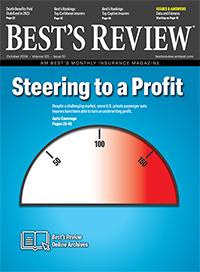Leadership 2.0: Preparing Leaders
Generation Next
With boomers retiring and leadership requirements changing, the industry could face a leadership gap if it fails to develop its internal talent, especially Gen X.
Key Points
- Executive Exodus: As baby boomers retire, the industry could struggle to fill the leadership gap.
- Silent Generation: Companies focus on millennials and baby boomers, but training Generation X should be a priority.
- Broad Exposure: In an industry of specialists, companies need more generalists.
Of the 50 chief executive officer searches The Jacobson Group has done in the past four years, each was to replace a baby boomer.
“Literally, all have been the result of retirement,” Greg Jacobson, co-CEO of The Jacobson Group, said.
It's a trend that's bound to continue. And it's also a trend that could prove problematic for insurers.
As baby boomers set off into retirement, the insurance industry is facing a potential leadership shortage. Not only has the industry failed to attract enough talent to replace those retiring, but it also has failed to prepare existing talent—particularly Generation X—to take over the top management spots.
“Organizations have missed the boat on talent development across the board,” said Limore Zilberman, a consultant at executive search firm Russell Reynolds Associates. “They more recently have done better in focusing on the talent development of their senior leaders. But by the time you're a senior leader, if you haven't collected all the arrows for your quiver along your whole career path, you're at a real disadvantage when it comes to being considered for CEO succession.”
This problem is not new per se; experts say the industry has never excelled at training leaders. But the issue is now magnified by three key factors—retirement, a hot job market and digital transformation.
Senior leaders are retiring en masse, triggering panic over the institutional knowledge walking out the door. Unemployment rates have been at or near record lows, which has created talent wars for top performers. And the insurance industry is going through a time of significant transformation, which means tomorrow's leaders need different skill sets than their predecessors.
The collision of those forces has brought leadership development to the front burner.
While simple numbers do play a role in the looming leadership shortage, the size disparity of generations is not the driving factor. (Generation X, which logically should be next in the leadership line, is significantly smaller than the baby-boom generation.)
The bigger issue is a lack of internal talent development both downstream within organizations and across the whole life cycle of employees. Middle management, which should be a breeding ground for future leaders, has been neglected, experts say. And even those who are being groomed may not be receiving the right training, as many organizations fail to recognize the need to change their leadership qualifications.
“Too many companies say, 'This is what our great CEO has done for us, so we're looking for someone who's like our great CEO,''' Jacobson said. “But, wait a second, the great CEO took the organization from one place to another place. What are the next 10 years going to look like? Who can take you through the next changes?”
Identifying and preparing those next gen leaders will be key to staving off a leadership gap.
“I wouldn't say the crisis is here yet,” Laurie O'Shea, the global sector leader of Korn Ferry's insurance practice, said. “I would say, if we wait any longer we'll have a leadership gap on our hands.”

Organizations have kept people in very narrow swim lanes and have been very focused on their technical contributions.
Limore Zilberman
Russell Reynolds Associates
Narrow Lanes
Insurance has been an industry of silos. Employees traditionally have lived in the underwriting world. They've lived in the claims world. They've lived in the finance world.
“This was an industry that was built on specialization,” Zilberman said. “People were hired because of their technical prowess and because of their technical acumen and their technical contribution.
“Organizations have kept people in very narrow swim lanes and have been very focused on their technical contributions.”
Leadership training, per se, was not a big focus.
“I wouldn't say the insurance industry ever invested a lot in leadership development. I would say they were the beneficiaries of specialization and trusted that great technical leaders could lead organizations,” O'Shea said. “And in the past, that was very, very true. Think of all the extraordinary actuaries, CFOs, people who came up through the technical side of the business who have been chief executive officers in our industry and have done very well,” O'Shea said.
That worked well enough in the past, but experts say it won't work in the future. Technology is creating new demands on talent and leadership.
“Albeit [technical acumen] is still important in the success of an insurance company and the insurance industry as a whole, the landscape of leadership is going to change,” Zilberman added. “The expectations of leadership are going to change. Our technical talent is not necessarily well-poised to take on broader leadership capabilities.”
The industry therefore needs to train its specialists to become generalists.
“Have we gotten here because we're an industry filled with specialists? I would say yes, and a leadership gap can exist if we don't continue to develop general managers inside of organizations,” O'Shea said. “I don't think this is a problem that gets solved by musical chairs.
“The systemic answer is a greater investment in learning and development, and focusing on taking these extraordinary specialists and identifying early which specialist has the learning agility, the leadership, the inspiration, the vision, and the technological savvy to be able to step up and become a general manager.”

Compensation is going up very significantly for the top positions because the supply and demand is out of balance.
Greg Jacobson
The Jacobson Group
New Leaders
In today's environment of constant technological change, companies need a different type of leader to carry them into tomorrow.
Zilberman calls them “the best athletes.”
“They're agile, they're adaptable, they're quick learners, they're good problem solvers, they're forward-looking,” she said. “Frankly, that is the skill set insurance companies should be focused on. Those types of people can be put at the helm to manage the lower ranks of the organization that might carry more of that technical expertise.”
Learning agility—the ability to adapt to change, see around corners and anticipate what's coming—may be the most valuable tool in a modern executive's kit, experts say.
“It's incumbent upon insurance organizations to put the dollars behind the people that they believe are learning agile and can become general managers,” O'Shea said.
Not everyone has that ability, though. And not everyone who grew up within the traditional silos of insurance will have the capacity to lead in the new operating model.
“Our talent was brought up in an industry that was so traditionally organized, and that is not going to be the right operating model moving forward,” Zilberman said. “Frankly, those individuals might not have the right general management skill set to make the transition with insurance companies that want to be known for their technology capabilities.”
Jacobson said the problem can be seen across the C-suite. It's always been difficult to find CEOs, he said, with searches taking six to nine months in total. But it's becoming increasingly difficult and costly to find qualified candidates across the broader senior leadership landscape.
Part of the difficulty relates to corporate expectations. Many companies are searching for a unicorn—an executive without flaws. “Companies have to recognize that there are no perfect candidates,” Jacobson said. “Every individual has areas where they need development, regardless of their position.”
But there also is some truth to the notion that qualified candidates are lacking.
“It's a background numbers game,” Jacobson said. “There just aren't as many people who have the experience required for the next-level role.
“You can see it in compensation. Compensation is going up very significantly for the top positions because the supply and demand is out of balance.”
Restoring balance requires a greater investment in Gen X.
“We're so focused on how to attract and retain and challenge millennials. And we're so focused on baby boomers. But it's the Gen X generation that needs the investment, because they're the leaders of the future for the industry as a whole,” Zilberman said. “We need to equip them with the right skill set to be able to succeed in a landscape that is going to look very, very different.”
With employee assessments readily available, experts say, it's easy enough to identify which employees have industry experience, but also are nimble enough to embrace new ways.
“We've been very good thus far at gathering assessment information,” O'Shea said. “The real question the industry is faced with is: With all the data you have on your people, what are you going to do to exponentially accelerate and help create a leader, a general manager?”
Training Ground
The solution, experts say, lies in exposure. In practical terms, that could mean more rotational assignments to expose potential leaders—particularly the Gen Xers—to various parts of the business.
“The 36- to 53-year-olds can still come up through the underwriting ranks, the product management ranks or the financial officer ranks,” O'Shea said. “But are we really preparing them to move from finance to underwriting to product? If you start them at 36 and have the right rotation for them, then when they are 45 or 48 and getting ready to be CEO, they won't have had a siloed experience.” Zilberman agreed that cross-functionality should be a priority.
“Going forward, what you need to do to cover the gap is ensure that you're giving your internal talent a lot more internal mobility and that you're really breaking down the organizational silos across functions,” Zilberman said.
“You need to find ways in which talent, especially your high-performing talent, can work cross-functionally and contribute cross-functionally.
“I do think that organizations have a ripe opportunity to think about this cross-pollinization of talent internally.”
Zilberman also suggested organizations focus on experiential learning and an apprenticeship model, which would help transfer knowledge from baby boomers.
“There is a ton of institutional knowledge that is literally about to walk out the door,” she said.
The industry still has a few years to course correct, experts say. But time is not on its side.
“Insurance companies need to own this,” O'Shea said. “The development of general managers, the development of what is needed in a new type of leader, has to be embraced throughout the enterprise. It can't be thought of as, 'We only need to do this at the time of the CEO transition.'
“There is only one CEO role in every company. They might turn over every four or five years. In preparing for a CEO transition, you need to be thinking three to five years in advance about who the candidates are, what their developmental needs are and how to develop them. But the bigger issue is we are an industry of specialists. If we begin to take the 30-somethings and invest in their development to begin to think like enterprise leaders, to think about disruption and what's needed in the future, that's where the systemic change will come.”






















